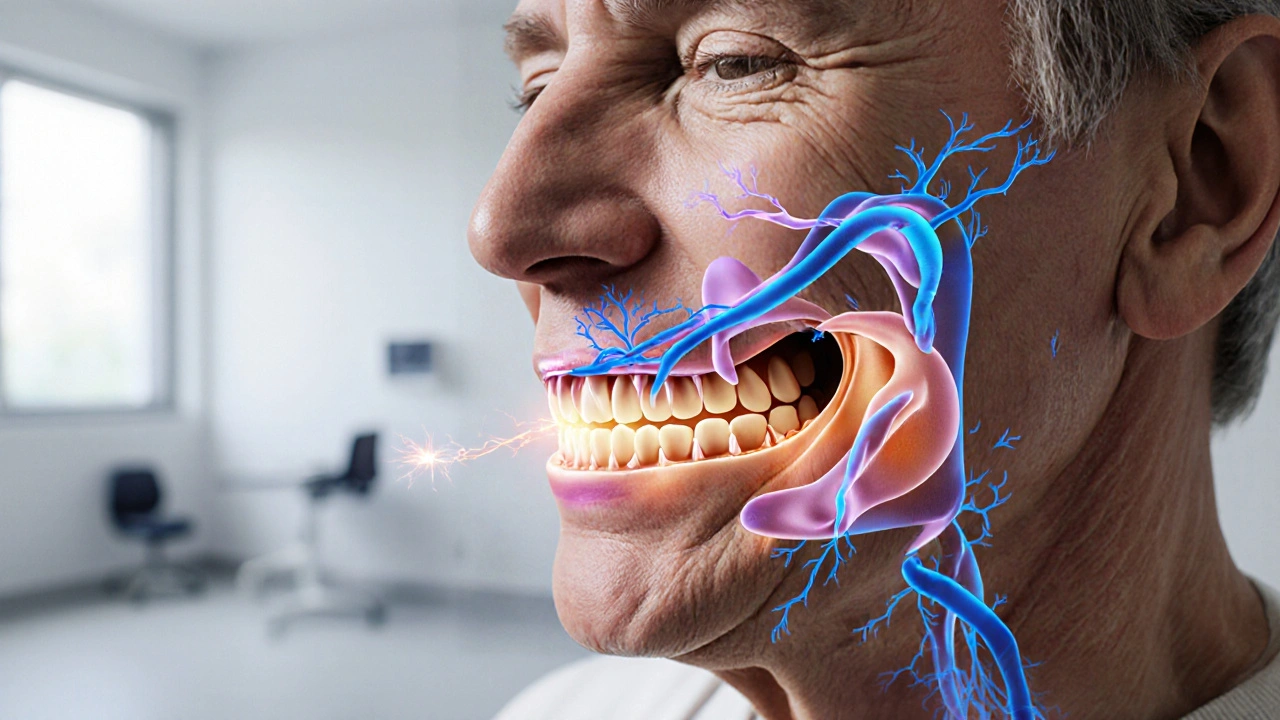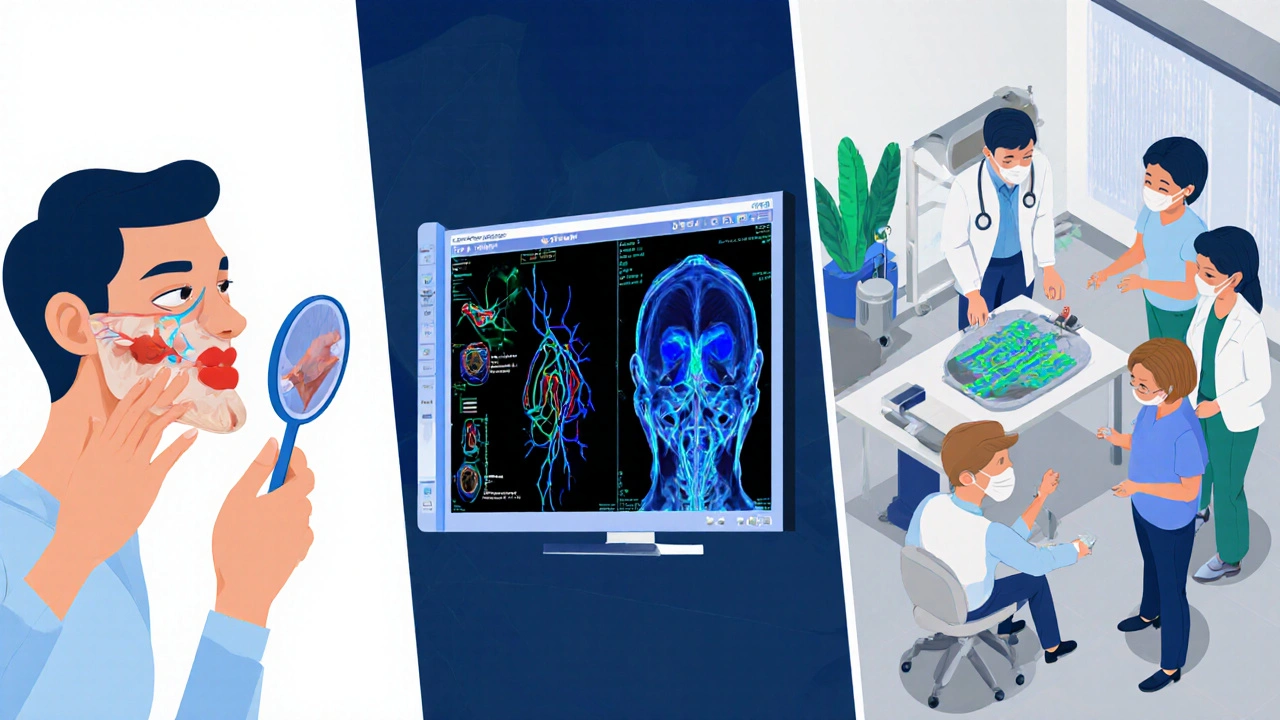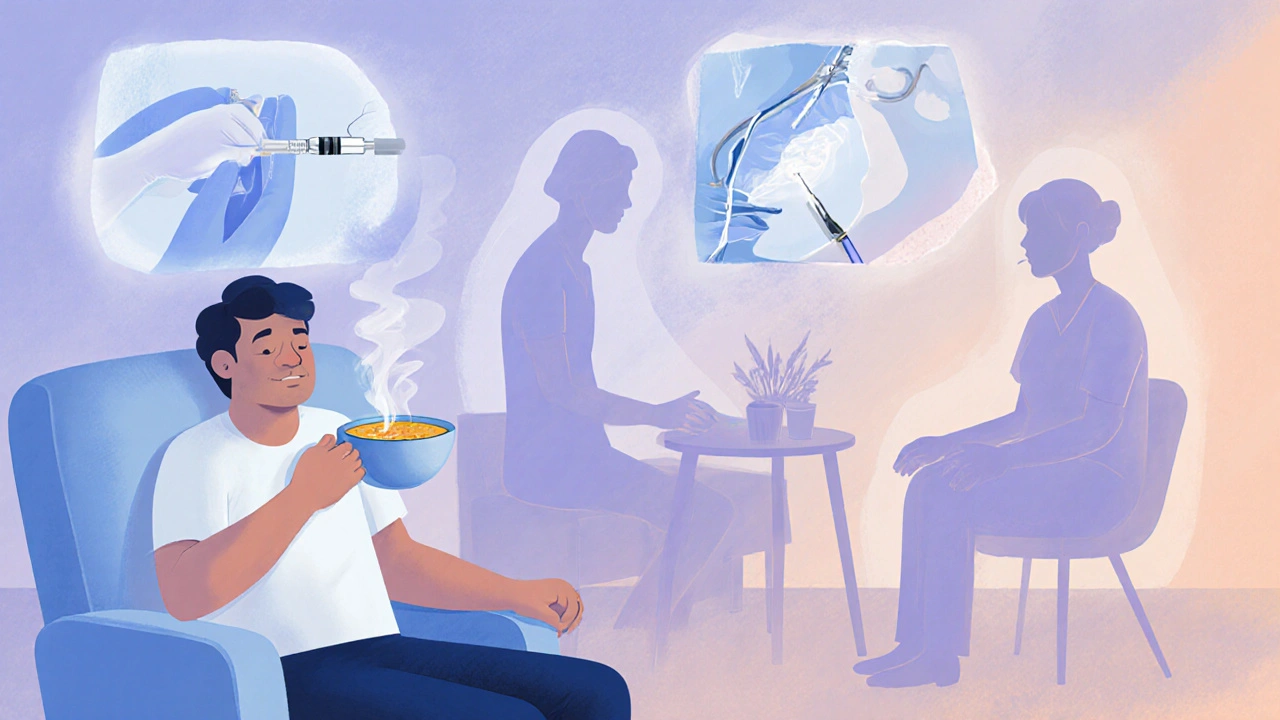Link Between Trigeminal Neuralgia and TMJ Disorders: Causes, Diagnosis & Treatment

Trigeminal Neuralgia & TMJ Disorder Symptom Checker
Symptom Assessment
Select symptoms you're experiencing. This tool will analyze common patterns between trigeminal neuralgia and TMJ disorders based on medical evidence.
Trigeminal Neuralgia Symptoms
TMJ Disorder Symptoms
Common Triggers
Results
Based on your symptoms
Next Steps:
When the face hurts, people often assume it’s a dental issue or a simple headache. But in many cases the pain comes from two complex conditions that can actually feed each other: Trigeminal Neuralgia is a chronic nerve disorder that causes sudden, electric‑shock‑like facial pain, while Temporomandibular Joint Disorder (TMJ Disorder) refers to a set of problems affecting the jaw joint and surrounding muscles. Understanding how these two overlap helps sufferers avoid misdiagnosis and find the right relief.
Key Takeaways
- Both conditions involve the trigeminal nerve system and can trigger each other’s symptoms.
- Shared risk factors include bruxism, stress, and nerve irritation from dental work.
- Accurate diagnosis typically requires a neurological exam, dental evaluation, and imaging such as MRI.
- Treatment is most effective when dentists, neurologists, and physical therapists coordinate care.
- Lifestyle changes-mindful chewing, stress management, and proper posture-can reduce flare‑ups.
What Is Trigeminal Neuralgia?
Trigeminal Neuralgia is a neuropathic condition affecting the fifth cranial nerve, which supplies sensation to the face. The pain is usually brief (seconds to minutes) but can repeat dozens of times a day, often triggered by light touch, chewing, or speaking. Classic descriptions compare the sensation to an electric shock or a knife slicing the cheek.
The root cause is often vascular compression-an artery or vein pressing on the trigeminal nerve root near the brainstem. Less common triggers include multiple sclerosis plaques, tumors, or facial trauma. Diagnosis relies on patient history, a neurological exam, and sometimes high‑resolution MRI to visualize nerve‑vascular contact.
What Is Temporomandibular Joint Disorder?
Temporomandibular Joint Disorder (TMJ Disorder) covers a range of problems involving the jaw hinge, the surrounding muscles, and the articular disc that cushions joint movement. Symptoms include jaw clicking, limited opening, headaches, and diffuse facial pain that can mimic neuralgic attacks.
Common contributors are teeth grinding (Bruxism), arthritis, injury, or misaligned bite. Because the TMJ sits close to the mandibular branch of the trigeminal nerve, inflammation in the joint can irritate nerve fibers, creating a painful feedback loop.

How the Two Conditions Interact
Although they originate from different structures, there are three main ways they overlap:
- Shared nerve pathways. The mandibular division of the trigeminal nerve supplies both the lower teeth and the TMJ. Irritation in the joint can amplify signals traveling along the same nerve that carries neuralgic pain.
- Trigger zone cross‑talk. A single trigger-like chewing gum-may provoke both a muscle spasm (TMJ) and a nerve shock (neuralgia) at the same time, making it hard for patients to pinpoint the source.
- Treatment side effects. Some medications for neuralgia (e.g., carbamazepine) can cause jaw muscle tension, while aggressive jaw splints used for TMJ can press on nerve branches and worsen neuralgic episodes.
Because of these interactions, many clinicians now view facial pain as a spectrum rather than isolated diagnoses.
Getting the Right Diagnosis
Accurate identification starts with a thorough history: timing, triggers, and pain quality. A skilled dentist will check for joint noises, range of motion, and bite alignment, while a neurologist looks for classic neuralgic patterns.
Key diagnostic tools include:
- Clinical examination. Palpation of the TMJ, muscle tenderness, and sensory testing of the facial skin.
- Imaging. High‑resolution MRI can reveal nerve compression, disc displacement, or joint inflammation.
- Electrodiagnostic studies. Nerve conduction tests help differentiate true neuropathic pain from muscular sources.
- Dental work review. Recent crowns, bridges, or orthodontic adjustments can irritate the trigeminal branches.
When both sets of findings appear, the clinician should label the case as “combined facial pain” and design a blended treatment plan.
Treatment Options That Address Both Conditions
There’s no one‑size‑fits‑all cure, but several evidence‑based approaches can hit both targets.
Medication Management
- Anticonvulsants. Carbamazepine and oxcarbazepine remain first‑line for neuralgia; they also dampen muscle hyperactivity that can aggravate TMJ.
- Muscle relaxants. Baclofen or tizanidine can reduce jaw muscle spasm, indirectly lowering nerve irritation.
- Low‑dose antidepressants. Amitriptyline helps with chronic pain modulation and improves sleep, which lessens bruxism.
Minimally Invasive Procedures
- Botulinum toxin injections. Botulinum Toxin delivered into the masseter and temporalis muscles eases TMJ tension while also blunting nerve firing in severe neuralgia cases.
- Radiofrequency lesioning. Targeted heat lesions on the trigeminal root can provide long‑lasting relief without open surgery.
- Arthrocentesis. Joint lavage removes inflammatory fluid, reducing pressure on the mandibular nerve.
Surgical Options
- Microvascular decompression (MVD). The gold‑standard neurosurgical fix for vascular compression of the trigeminal nerve; it can also improve TMJ‑related pain if nerve irritation was the primary driver.
- TMJ arthroscopy or open joint reconstruction. Reserved for severe disc displacement or arthritis that continues to irritate the nerve.
Therapeutic and Lifestyle Strategies
- Physical therapy. Physical Therapy focusing on jaw mobility, posture, and cervical spine alignment can lower both muscular and neural triggers.
- Custom oral splints. Night guards made from soft material reduce bruxism without excessive bite pressure that could compress the nerve.
- Stress reduction. Mindfulness, biofeedback, and regular aerobic exercise lower overall muscle tension, which in turn eases nerve irritation.
- Dietary adjustments. Soft‑food diets during flare‑ups prevent over‑loading the joint and lessen chewing‑related neuralgic spikes.

Putting It All Together: A Sample Care Path
- Initial assessment by a dentist: rule out obvious dental causes, fit a soft night guard, and refer to a neurologist if pain is shock‑like.
- Neurologist conducts MRI to visualize nerve‑vascular contact and prescribes low‑dose carbamazepine.
- If pain persists, schedule a botulinum toxin injection into masseter and temporalis muscles.
- Begin a 6‑week physical‑therapy program targeting jaw opening, cervical flexors, and postural correction.
- Re‑evaluate after 3 months; consider microvascular decompression only if medication and minimally invasive steps fail.
This stepped approach keeps invasive procedures as a last resort while addressing both neural and joint contributors.
Practical Tips to Keep Pain at Bay
- Chew slowly and on the side opposite the pain.
- Avoid extreme temperature foods that can trigger nerve firing.
- Maintain a neutral head position; slouching puts extra strain on the temporomandibular joint.
- Use a warm compress for 10 minutes before bedtime to relax jaw muscles.
- Schedule regular dental check‑ups; minor bite changes can snowball into full‑blown pain.
Frequently Asked Questions
Can trigeminal neuralgia cause TMJ pain?
Yes. When the trigeminal nerve is hyper‑excitable, the mandibular branch can send pain signals that feel like joint discomfort, even if the joint itself is healthy.
Is it safe to use a hard night guard if I have neuralgia?
Hard guards can increase pressure on the mandibular nerve, potentially worsening neuralgic attacks. Soft or dual‑layer splints are usually recommended.
What imaging modality best shows the link between the two conditions?
A high‑resolution MRI with constructive interference in steady state (CISS) sequences can reveal both nerve‑vascular contacts and TMJ disc displacement in one scan.
Do antidepressants help with jaw pain?
Low‑dose tricyclic antidepressants can lower overall pain perception and improve sleep, which indirectly reduces bruxism‑related jaw strain.
When is surgery really necessary?
Surgery is considered after at least three months of optimized medication, splint therapy, and minimally invasive procedures without lasting relief. Microvascular decompression or joint reconstruction are then evaluated on a case‑by‑case basis.
Understanding the bridge between trigeminal neuralgia and TMJ disorders transforms a vague facial ache into a treatable condition. By spotting shared triggers, seeking the right imaging, and working with a multidisciplinary team, patients can move from endless doctor hops to real, lasting relief.
Xing yu Tao
October 14, 2025 AT 16:42It is prudent to acknowledge that the convergence of trigeminal neuralgia and temporomandibular joint pathology represents a paradigmatic instance of interdisciplinary medicine. By examining the shared neuroanatomical pathways, clinicians can foster a more holistic diagnostic approach. Moreover, the emphasis on coordinated care aligns with best practice guidelines. Consequently, patients benefit from reduced misdiagnosis and expedited therapeutic interventions. In sum, the article commendably elucidates the symbiotic relationship between these two disorders.
Adam Stewart
October 26, 2025 AT 06:29Many readers might overlook how stress amplifies both conditions, yet the article makes that link clear. It encourages a gentle, inclusive mindset toward multidisciplinary treatment.
Selena Justin
November 6, 2025 AT 20:16Understanding the intricate overlap between facial nerve irritation and joint dysfunction can alleviate patient uncertainty. The detailed discussion of imaging modalities, particularly high‑resolution MRI, equips practitioners with concrete tools. Likewise, the emphasis on soft night guards respects the delicate balance between dental and neurological needs. Ultimately, this comprehensive perspective supports informed decision‑making without compromising empathy.
Freddy Torres
November 18, 2025 AT 10:02The nerve‑joint nexus explains why chewing can ignite electric shocks in some sufferers. Splint therapy and neuromodulators together target both sources. A clear, concise roadmap.
Andrew McKinnon
November 29, 2025 AT 23:49Oh great, another buzzword‑laden review promising to “normalize pain pathways” while ignoring the real‑world constraints of insurance formularies. The reliance on “microvascular decompression” sounds impressive, but without acknowledging peri‑operative morbidity, it reads like marketing copy. One must also critique the over‑use of terms like “neuro‑modulation” that obscure practical outcomes. Nonetheless, the article does sprinkle in some legitimate pharmacologic options.